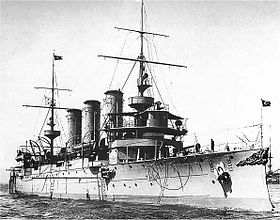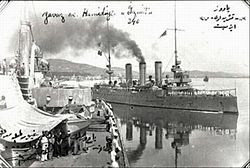- Ottoman cruiser Hamidiye
-

Ottoman cruiser HamidiyeCareer (Ottoman Empire) 
Name: Hamidiye Namesake: Sultan Abdul Hamid[disambiguation needed  ]
]Launched: September 25, 1903 Honours and
awards:Cruiser Hamidiye Medal 1913 Fate: Under British control 1918-1925, then ceded to Turkish Navy Career (Turkey) 
Name: Hamidiye Commissioned: 1925 Decommissioned: 1947 Notes: Used for cadet training starting 1940 General characteristics Hamidiye Type: Light Cruiser[1] Displacement: 3,805 tons Length: 112 m (367 ft) Beam: 14.5 m (48 ft) Draught: 4.8 m (16 ft) Propulsion: 2 VTE 4 cyl; 12,000 hp Speed: 22 knots Complement: 302 Armament: 2 x 150mm L/45 guns
6 x 120mm L/50 guns
2 x 46mm L/50 guns
2 x 36mm guns
2 x 457mm torpedo tubesHamidiye[Note 1] was an Ottoman cruiser that saw extensive action during the Balkan Wars and World War I. Initially named Abdül Hamid, it was launched on 25 September 1903 in England, weighed 3,805 tons, had a draught of 4.8m, was 112m long and was named after the Ottoman Sultan Abdül Hamid[disambiguation needed
 ].
].It had two 150mm L/45 quick firing guns, six 120mm L/50 quick firing guns, two 46mm L/50 quick firing guns, two 36mm quick firing guns, and two 457mm torpedo tubes. Hamidiye was powered by two sets of 4-cylinder triple expansion steam engines providing a top speed of 22 knots and carried a nominal complement of 302.
It was named Hamidiye after the 1908 Young Turk Revolution. Under the terms of the Treaty of Sèvres, which ended the First World War between the Allies and the Ottoman Empire, the ship was to be handed over to Great Britain as war compensation. However, the ensuing Turkish War of Independence culminated in the abrogation of the Treaty of Sèvres; it was replaced by the Treaty of Lausanne, which permitted the new Turkish republic to retain its fleet, including Hamidiye, which became a training ship.
Contents
Design
General characteristics
Hamidiye was 340 ft (103.63 m) long, and had a beam of 47 ft 6 in (14.48 m) and a draft of 16 ft (4.88 m). The ship displaced 3,830 t (3,770 long tons; 4,220 short tons) with a normal load. She was protected by Krupp armor. The armor system consisted of a main armored deck: the horizontal portions were 1.5 in (3.8 cm) thick, while the slopes on the sides of the ship were 4 in (10 cm) thick. Hamidiye was powered by 2-shaft vertical triple expansion engines, which were supplied with steam by cylindrical boilers. The power plant was rated at 12,500 indicated horsepower, which produced a top speed of 22 knots (41 km/h; 25 mph).[2]
Armament
Hamidiye was armed with a wide array of medium and smaller caliber guns. The largest of these were two 6 in (15 cm) /45 Armstrong quick-firing guns each mounted in its own turret, one forward and one aft.[2] These guns fired 100 lb (45 kg) projectiles at a rate of 5 to 7 rounds per minute. The mounts allowed elevation to 20°, which provided a maximum range of 14,600 yards (13,350 m).[3] Eight 4.7 in (12 cm) /50 Armstrong quick-firing guns rounded out the primary armament; these were placed in single mounts amidships, four on either side.[2]
Secondary weapons consisted of six 3-pounder guns and six 1-pounder guns, each mounted in single emplacements. Hamidiye also carried a pair of 18 in (46 cm) torpedo tubes; these were emplaced in two aim-able mounts underneath the forebridge.[2]
After the First World War, Hamidiye was rearmed; both types of primary guns were removed, and replaced with 5.9 in (15 cm) SK L/45 and 3 in (7.6 cm) SK L/50 Krupp guns.[2]
Service history
1908–1909
Hamidiye was involved in putting down a Greek uprising at Samos Island in 1908. In 1909 it was attached to the army which, under Mahmud Şevket Pasha, marched on Istanbul to put down the counter-revolution (31 March Incident), and anchored off Yeşilköy, across from Sevket Pasha's headquarters.
Balkan Wars
 Rauf Orbay, the captain of the Hamidiye during the Balkan Wars.
Rauf Orbay, the captain of the Hamidiye during the Balkan Wars.
The Hamidiye fought in the Balkan Wars under the command of Captain Rauf Orbay, and was the only Ottoman ship to distinguish itself in the conflict.[4] In November 1912, while shelling Bulgarian positions during the First Balkan War, the Hamidiye was damaged by the Bulgarian torpedo boat Drazki,[5] though Orbay claimed to have sunk two other torpedo boats.[6] The torpedo tore a 10 ft (3.0 m) hole in her bow on the starboard side, and killed eight men.[7] Though the bow was mostly submerged, it was able to withdraw back to home port for repairs. On 14 January 1913, the Hamidiye slipped through the Greek naval blockade of the Dardanelles under cover of night, and proceeded to raid Greek shipping in the Aegean. The next day, at Syros, it sunk the Greek armed merchantman Makedonia and shelled the town of Ermoupoli. From there it set sail to Beirut and Port Said.[8][9] The raids of the Hamidiye and its ability to roam around the Mediterranean and sow confusion, disrupt shipping and destroy various ships and facilities while avoiding its pursuers became a major morale booster for the Ottomans. The main aim of its sally however, to draw away the Greek cruiser Averof so as to enable the Ottoman fleet to tackle the rest of the Greek navy in support of the Ottoman land forces, failed.
Orbay then led his ship to shell Greek and Serbian positions on the coast of Albania. At San Giovanni di Medua (Turkish: Şingin) on 12 March 1913, it sunk six Greek merchant ships and heavily damaged an Austrian ship, as well as shelling the Serbian military encampment there. Evading the Greek destroyers sent to find it, Hamidiye set sail for Egypt. Another sortie south of Crete led to the capture of another Greek merchantman, but reports of Greek warships near Rhodes forced the Hamidiye, whose boilers were damaged and reduced her speed, to seek refuge in the Red Sea, where it sat out the end of the war.[9]
World War I
During World War I, it fought against the Russian Navy in Black Sea and joined Yavuz and Midilli in maintaining control over Black Sea lanes and ports. It engaged in numerous naval battles, was hit many times. Hamidiye conducted a series of operations in company with Yavuz and Midilli; on 23 September 1914, Hamidiye sailed with Yavuz to Trebizond to escort three transports.[10] In November it bombarded military installations at Russian port Tuapse. The ship sortied again in January 1915 along with Midilli; on 9 January the two ships accidentally encountered the Russian fleet off Yalta. In the brief engagement, Midilli hit the Russian battleship Evstafi once. On their return they were pursued by ships of the Russian fleet. The recently repaired Yavuz steamed out of the Bosporus to cover the arrival of Hamidiye and Midilli and force off the pursuing Russians.[11]
The war between the Allies and the Ottoman Empire was ended with the signing of the Treaty of Sèvres on 10 August 1920; according to the terms of the treaty, Hamidiye, along with Yavuz and several other warships, was to be ceded to Great Britain as war reparations.[12] However, the Turkish War of Independence, led by Mustafa Kemal Atatürk, eventually created a new Turkish state; the treaty of Sèvres was discarded, and the Treaty of Lausanne was signed in its place. Under the terms of this treaty, the new Turkish republic regained possession of much its fleet.[12] It was the first[citation needed] Ottoman warship to be transferred to the Turkish Navy in 1925.
Awards
The only commemorative military medal issued by the Ottomans for the Balkan Wars was the Cruiser Hamidiye Medal 1913, which was given to each of the ship's 394 crew members.[13]
The ship was decommissioned in 1947 after a service of training cadets since 1940. For a short while it was a museum ship. Hamidiye was then laid up in İstanbul in 1951 and then sold for scrap in 1964.
Notes
- ^ The name is also sometimes rendered as Hamidieh in English; see Gardiner and Gray, p. 389 and Halpern, p. 228.
Footnotes
- ^ Nicolle, David and Raffaele Ruggeri, p. 34
- ^ a b c d e Gardiner, Chesneau, & Kolesnik, p. 392
- ^ DiGiulian, Tony (21 January 2009). "British 6"/45 (15.2 cm) BL Mark VII 6"/45 (15.2 cm) BL Mark VIII 6"/45 (15.2 cm) BL Mark XXIV". Navweaps.com. http://www.navweaps.com/Weapons/WNBR_6-45_mk7.htm. Retrieved 8 December 2009.
- ^ Hough, pp. 66–67
- ^ Sondhaus, p. 219
- ^ Hough, p. 67
- ^ Gardiner and Gray, p. 389
- ^ Hall, p. 200, p. 65
- ^ a b "Hamidiye". Turkey in the First World War. http://www.turkeyswar.com/navy/battleships-hamidiye.htm. Retrieved 2009-12-04.
- ^ Halpern, p. 228
- ^ Halpern, pp. 228–229
- ^ a b Gardiner and Gray, p. 388
- ^ http://www.turkishmedals.net/campmedals.htm
Bibliography
Books
- Gardiner, Robert; Gray, Randal, eds (1984). Conway's All the World's Fighting Ships: 1906–1922. Annapolis: Naval Institute Press. ISBN 0870219073.
- Gardiner, Robert; Chesneau, Roger; Kolesnik, Eugene M., eds (1979). Conway's All the World's Fighting Ships: 1860–1905. London: Conway Maritime Press. ISBN 0-85177-133-5.
- Hall, Richard C. (2000). The Balkan Wars, 1912-1913: prelude to the First World War. Routledge. ISBN 9780415229463.
- Hough, Richard (1966). The Big Battleship. Periscope Publishing Ltd.. ISBN 9781904381143.
- (Turkish) İnci, Tevfik (1952). Hamidiye's Raids During The Balkan Wars (Balkan Harbinde Hamidiye Kruvazörünün Akın Harekâtı). Istanbul, Turkey: Deniz Basımevi.
- David Nicolle and Raffaele Ruggeri, The Ottoman Army 1914-18, Osprey Publishing Ltd., 1994.
- (Turkish) Saraçoğlu, A Cemaleddin (2006). Rauf Orbay and Hamidiye : Veteran Hamidiye's Glory and Adventures (Rauf Orbay ve Hamidiye : Gazi Hamidiye'nin şanlı maceraları). Istanbul, Turkey: Yeditepe.
- Sondhaus, Lawrence (2001). Naval warfare, 1815-1914. Routledge. ISBN 9780415214780.
Online
- DiGiulian, Tony. "Navweaps.com: Naval Weapons, Naval Technology and Naval Reunions". Bucks County, Pennsylvania. http://www.navweaps.com/.
- http://www.turkeyswar.com/navy/battleships-hamidiye.htm
Categories:- Ships built in the United Kingdom
- Armstrong Whitworth ships
- Naval history of the Ottoman Empire
- Cruisers of the Ottoman Navy
- Naval ships of the Ottoman Empire in the Balkan Wars
- World War I cruisers of the Ottoman Empire
- Cruisers of the Turkish Navy
- 1903 ships
Wikimedia Foundation. 2010.

